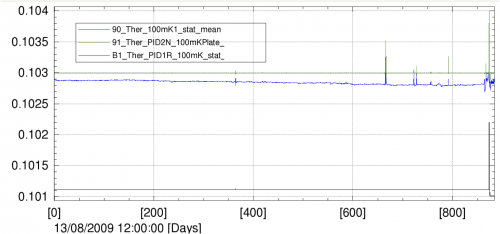HFI design, qualification, and performance
The inversion of HFI data requires that one knows how the instrument selects photons, how these photons are transformed in data transmitted by telemetry and what spurious signals are added in this process.
Contents
HFI high level description and Architecture[edit]
(Lamarre/Pajot) Should be short, understandable and point through links to the relevant sections and papers.
Cryogenics[edit]
(F .Pajot)
Dilution[edit]
(including PIDs)
The HFI 3He-4He dilution cooler produces temperatures of 0.1 K for the bolometers through the dilution of 3He into 4He and 1.4 K through JT expansion of the 3He and 4He mixture. The dilution cooler is described in detail in [Planck early results. II. The thermal performance of Planck, 2.3.3. Dilution cooler].
The dilution was operated with flows set to the minimum available value, and provided a total lifetime of 30.5 months, exceeding the nominal lifetime of 16 months by 14.5 months. The dilution stage was stabilized by a PID control with a power comprised between 20 and 30 nW providing a temperature near 101 mK. The bolometer plate was stabilized at 102.8 mK with a PID power around 5 nW [fig. 100mK_stability.png].
(here a few lines of 100 mK boloplate stability)
Detailed of the in-flight performance of the dilution cooler can be found in [Planck early results. II. The thermal performance of Planck, 4.4. Dilution cooler]
4K J-T cooler[edit]
(including PIDs for details links to the early cryogenic paper (need to add data ?))
The HFI 4K J-T cooler produces a temperature of 4K for the HFI 4K stage and optics and the precooling of the dilution gases. Full description of the 4K cooler can be found in [Planck early results. II. The thermal performance of Planck, 2.3.2. 4He-JT cooler].
The 4K cooler was operated without interruption during all the survey phase of the mission. It is still in operation as it also provides the cooling of the optical reference loads of the LFI. The 4K PID stabilizing the temperature of the HFI optics is regulated at 4.81 K using a power around 1.8 mW [fig. 4K -A VENIR-].
(here a few lines of 4K stability, including compressors operation)
Details on the in-flight performance of the dilution cooler can be found in [Planck early results. II. The thermal performance of Planck, 4.3. 4He-JT cooler]
Cold optics[edit]
(Lamarre)
Horns,lenses[edit]
links to Peter's paper
filters, band[edit]
Includes Locke's very detailed document.
Detection chain[edit]
(Francesco Piacentini)
Bolometers[edit]
JFETs[edit]
Readout[edit]
Data compression[edit]
Time response.[edit]
Links to Brendan's paper. Additional data if needed. Written by Brendan.
System (Ken)[edit]
List of systematics[edit]
Summary[edit]
(Lamarre) here remind worse sytematics and point to DPC Summary of sucess and limitations. JML. Link to early HFI in flight perf.
(Planck) High Frequency Instrument
(Planck) Low Frequency Instrument
Data Processing Center
